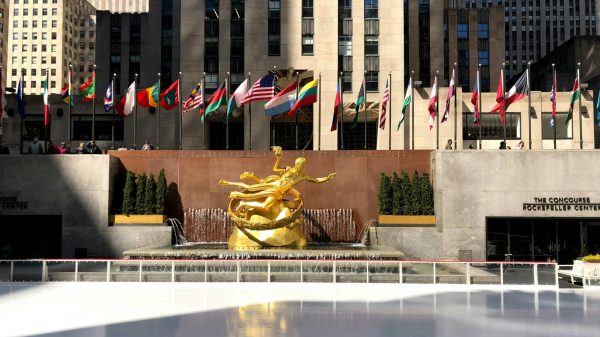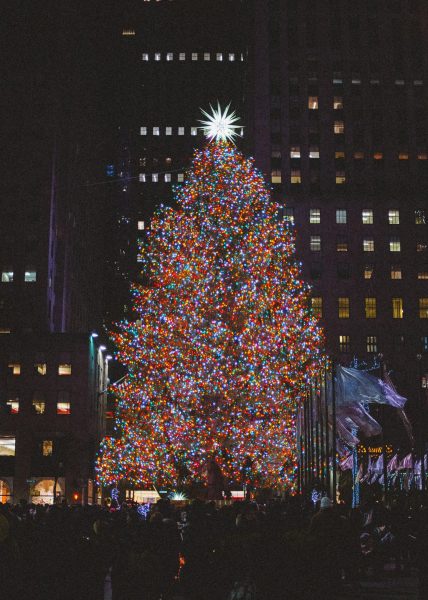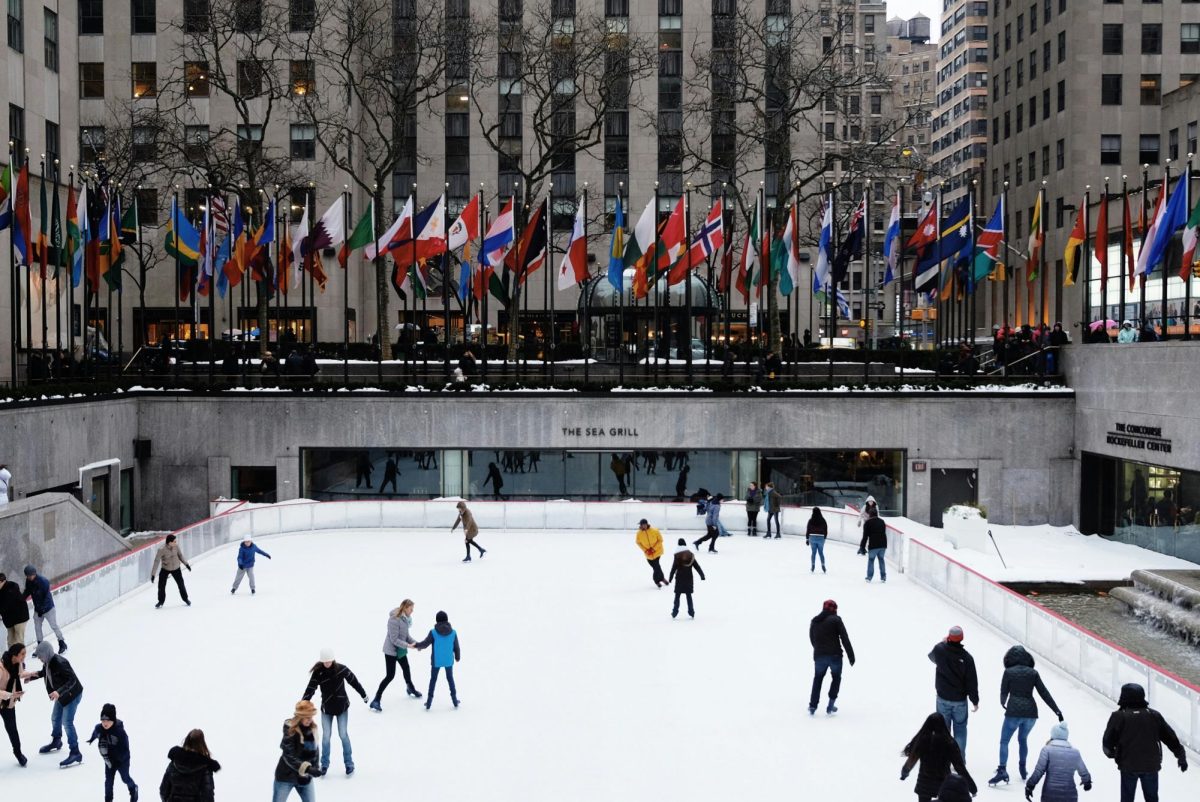As the winter chill begins to blanket the city, New York becomes a center of holiday cheer. Illuminated snowflakes are strung across intersections, glittering window displays are perfectly arranged, and although the winter months may be glum and gloomy in terms of the weather, a feeling of holiday joy is apparent. Finally, it’s the time of the year to take out your stockings, dusty ornaments, cookie cutters, earmuffs, and most importantly, your ice skates.
Nestled among the upscale shops on Fifth Avenue, Rockefeller Center stands as one of the most notable destinations in the classic New York holiday experience.
Legend has it that the idea for the rink was inspired by an ice skate salesman during the Great Depression who advertised it by skating on the frozen water of the Rockefeller Center fountain. Because of the economic conditions at the time, Rockefeller Center was struggling to attract shoppers to the high-end stores in the underground concourse. They figured that a rink would attract crowds, providing just the solution to the stalled profits, by bringing wonder back into the lives of the public. And so, the holiday magic was born.
The Rink at Rockefeller Center, or “skating pond” as it was first known, officially opened on Christmas Day in 1936. Although it was originally planned as a temporary exhibit, The Rink was so popular that it became a permanent addition to the plaza, and with the Prometheus Statue and Christmas Tree, Rockefeller Center at Christmastime became a familiar scene all over the world.
The rink is a stage for performance and recreation alike, home to a spectrum of talent — from novices taking their tentative first steps to seasoned skaters crafting intricate routines, and even occasional spontaneous performances that draw applause from onlookers.
Crowds of both tourists and New York natives line the sides of the sunken plaza, as people lean over the rail as they watch the skating activity below. With crowds that can be up to five-feet thick, it takes a good push or a clever maneuver to catch a glimpse of the action on the ice.
One spectator, Robert Scott, said, “I feel like I’m standing in a special place, a place most people travel miles and oceans to see. And all I had to do was to take the subway to get here.” After twenty-eight years of living in New York City, it was his first time ever visiting Rockefeller Center during the holiday season. “I can’t believe I never went before,” Scott said.
Many locals share this experience — taking for granted an important tradition that is in their own backyard, thinking that it will too crowded or too cliché. Scott commented that “many New Yorkers should break out of this idea that experiences like this are too… basic. Who cares? It’s definitely worth it.”

Adjacent to the skating rink stands the timeless bronze statue of Prometheus, the Greek mythological figure known for giving fire to mankind, and symbolizing enlightenment. Surrounded by the skaters and strings of holiday lights above, the statue serves as a silent witness to the merriment and jubilation that envelops the plaza.
This colossal 18-foot, eight-ton statue can be seen on Fifth Avenue, positioned against the western wall of the plaza. Beyond its striking visual, the statue’s history is intertwined with people’s longstanding interest in Greek mythology and art.
Prometheus symbolizes the ambition of people striving for the greater good of the human race. According to myth, Prometheus defied the Olympian gods by stealing the gift of fire and giving it to humans, instead. If one looks closely, they can spot the words “Prometheus, teacher in every art, brought the fire that hath proved to mortals a means to mighty ends,” engraved into the plaque beneath the golden statue.
The statue was originally an homage to John D. Rockefeller in recognition of his bestowal of oil to America in the 1930s, which significantly moved society forward with progress, just as fire did to people in the myth. Both oil and fire significantly shaped the trajectory of technology and innovation, allowing the world to industrialize and modernize. Rockefeller even said he was inspired by Prometheus and requested that the statue be built of him.
Though through his exploitation of oil prices and monopoly on the industry, Rockefeller could arguably also play the part of the evil gods. Nevertheless, Prometheus stands as the emblem of people’s curiosity and progress, as the glittering golden figure of the rink.

Turning into the center of the plaza in front of the rink, one get’s the first glimpse of the annual Rockefeller Center Christmas tree. Erik Pauzé, the Head Gardener at Rockefeller Center, said the tree’s “gotta look good for those kids who turn the corner at 30 Rock; it needs to instantly put a huge smile on their faces. It needs to evoke that feeling of happiness.” It truly does that. Whether looking through the camera of an observer or by a rare moment of direct view, it’s clear the tree exudes a spectacular wonder.
In 1931, amid the Depression and construction of Rockefeller Center, Italian-American workers set up the first Christmas tree at the site, pooling together meager funds. On Christmas Eve, they adorned a modest 20-foot balsam fir (now the trees are up to 95 feet) with lines of threaded cranberries, paper garlands, and a few tin cans as ornaments.
The tree was a hit. Due to its immediate popularity, Rockefeller Center decreed that it was an official annual tradition, two years later. Since then, the tree has become a symbol of the holidays, currently attracting over 125 million visitors per year.
Now, to pick the iconic tree, Erik Pauzé visits nurseries throughout the tri-state area and sorts through online submissions looking for a unique candidate. Once the festivities are over, the tree is donated to an organization called, Habitat for Humanity which then uses the lumber to build homes for low-income families.
Keeping in the spirit of its creation, the tree is a communal project; workers contribute funds, and families craft the decorations. Anyone can be part of this family gathering, except this one is crowned by a star of Swarovski crystals.
However, amidst the festivity, the commercialization of these spaces is unmistakable. This iconic tree, while an emblem of holiday spirit and tradition, also serves as a promotional centerpiece. Corporate sponsorships and televised events surrounding the tree lighting ceremony are platforms for news brands and hosts to gain exposure, unfortunately blurring the boundaries between celebration and commercial endorsement.
The 125 million people aren’t just 125 million people having a good time, but 125 million customers.
Even the ice skating stays in line with its origins in advertisement, offering visitors the opportunity to partake in a quintessential New York holiday tradition for a hefty price. The surrounding vendors strategically position themselves nearby, offering an array of merchandise ranging from touristy trinkets to steaming beverages and delectable snacks.
Yet, amidst the hustle and bustle of commerce, an undeniable allure and enchantment persists. The twinkling lights, the buzzing crowds, and the tangible energy infuse Rockefeller Center with a captivating charm that transcends consumerism. Visitors revel in the spectacle of Rockefeller Center, finding delight and connection amidst the glitz and glamor.
There’s a reason this area is marketed as the ideal place. Perhaps some are aware of the commercialization, yet year after year they find themselves drawn to it.
Ice skating at Rockefeller Center is more than the act of gracefully gliding on frozen water; it has evolved into a cherished experience for families, friends, and strangers alike. The photos that people take together, the music, the frozen noses, the cozy nooks for hot chocolate drinkers, and the smiles that just won’t melt away all make Rockefeller center a truly magical place.
You can visit the Rink at Rockefeller Center through March 24th, 2024; tickets can be purchased HERE.
Ice skating at Rockefeller Center is more than the act of gracefully gliding on frozen water; it has evolved into a cherished experience for families, friends, and strangers alike.

